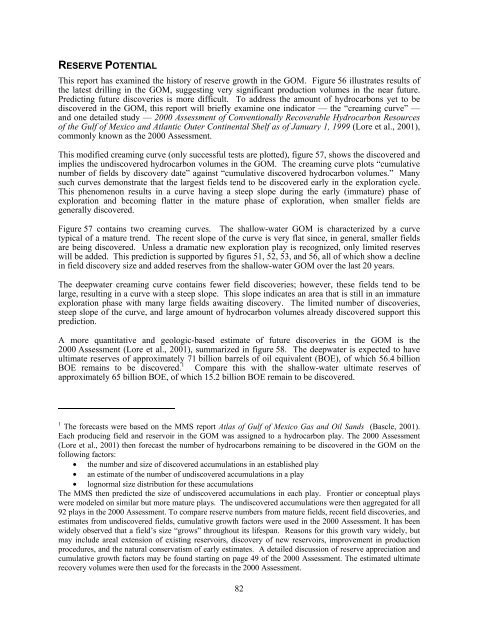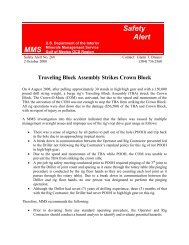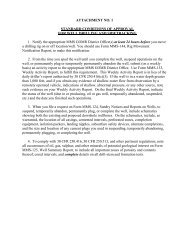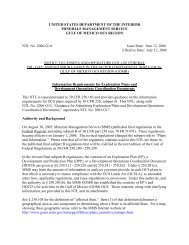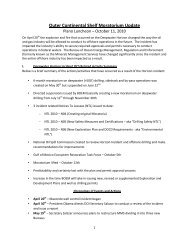Deepwater Gulf of Mexico 2004: America's Expanding ... - OCS BBS
Deepwater Gulf of Mexico 2004: America's Expanding ... - OCS BBS
Deepwater Gulf of Mexico 2004: America's Expanding ... - OCS BBS
- No tags were found...
You also want an ePaper? Increase the reach of your titles
YUMPU automatically turns print PDFs into web optimized ePapers that Google loves.
RESERVE POTENTIAL<br />
This report has examined the history <strong>of</strong> reserve growth in the GOM. Figure 56 illustrates results <strong>of</strong><br />
the latest drilling in the GOM, suggesting very significant production volumes in the near future.<br />
Predicting future discoveries is more difficult. To address the amount <strong>of</strong> hydrocarbons yet to be<br />
discovered in the GOM, this report will briefly examine one indicator — the “creaming curve” —<br />
and one detailed study — 2000 Assessment <strong>of</strong> Conventionally Recoverable Hydrocarbon Resources<br />
<strong>of</strong> the <strong>Gulf</strong> <strong>of</strong> <strong>Mexico</strong> and Atlantic Outer Continental Shelf as <strong>of</strong> January 1, 1999 (Lore et al., 2001),<br />
commonly known as the 2000 Assessment.<br />
This modified creaming curve (only successful tests are plotted), figure 57, shows the discovered and<br />
implies the undiscovered hydrocarbon volumes in the GOM. The creaming curve plots “cumulative<br />
number <strong>of</strong> fields by discovery date” against “cumulative discovered hydrocarbon volumes.” Many<br />
such curves demonstrate that the largest fields tend to be discovered early in the exploration cycle.<br />
This phenomenon results in a curve having a steep slope during the early (immature) phase <strong>of</strong><br />
exploration and becoming flatter in the mature phase <strong>of</strong> exploration, when smaller fields are<br />
generally discovered.<br />
Figure 57 contains two creaming curves. The shallow-water GOM is characterized by a curve<br />
typical <strong>of</strong> a mature trend. The recent slope <strong>of</strong> the curve is very flat since, in general, smaller fields<br />
are being discovered. Unless a dramatic new exploration play is recognized, only limited reserves<br />
will be added. This prediction is supported by figures 51, 52, 53, and 56, all <strong>of</strong> which show a decline<br />
in field discovery size and added reserves from the shallow-water GOM over the last 20 years.<br />
The deepwater creaming curve contains fewer field discoveries; however, these fields tend to be<br />
large, resulting in a curve with a steep slope. This slope indicates an area that is still in an immature<br />
exploration phase with many large fields awaiting discovery. The limited number <strong>of</strong> discoveries,<br />
steep slope <strong>of</strong> the curve, and large amount <strong>of</strong> hydrocarbon volumes already discovered support this<br />
prediction.<br />
A more quantitative and geologic-based estimate <strong>of</strong> future discoveries in the GOM is the<br />
2000 Assessment (Lore et al., 2001), summarized in figure 58. The deepwater is expected to have<br />
ultimate reserves <strong>of</strong> approximately 71 billion barrels <strong>of</strong> oil equivalent (BOE), <strong>of</strong> which 56.4 billion<br />
BOE remains to be discovered. 1 Compare this with the shallow-water ultimate reserves <strong>of</strong><br />
approximately 65 billion BOE, <strong>of</strong> which 15.2 billion BOE remain to be discovered.<br />
1 The forecasts were based on the MMS report Atlas <strong>of</strong> <strong>Gulf</strong> <strong>of</strong> <strong>Mexico</strong> Gas and Oil Sands (Bascle, 2001).<br />
Each producing field and reservoir in the GOM was assigned to a hydrocarbon play. The 2000 Assessment<br />
(Lore et al., 2001) then forecast the number <strong>of</strong> hydrocarbons remaining to be discovered in the GOM on the<br />
following factors:<br />
• the number and size <strong>of</strong> discovered accumulations in an established play<br />
• an estimate <strong>of</strong> the number <strong>of</strong> undiscovered accumulations in a play<br />
• lognormal size distribution for these accumulations<br />
The MMS then predicted the size <strong>of</strong> undiscovered accumulations in each play. Frontier or conceptual plays<br />
were modeled on similar but more mature plays. The undiscovered accumulations were then aggregated for all<br />
92 plays in the 2000 Assessment. To compare reserve numbers from mature fields, recent field discoveries, and<br />
estimates from undiscovered fields, cumulative growth factors were used in the 2000 Assessment. It has been<br />
widely observed that a field’s size “grows” throughout its lifespan. Reasons for this growth vary widely, but<br />
may include areal extension <strong>of</strong> existing reservoirs, discovery <strong>of</strong> new reservoirs, improvement in production<br />
procedures, and the natural conservatism <strong>of</strong> early estimates. A detailed discussion <strong>of</strong> reserve appreciation and<br />
cumulative growth factors may be found starting on page 49 <strong>of</strong> the 2000 Assessment. The estimated ultimate<br />
recovery volumes were then used for the forecasts in the 2000 Assessment.<br />
82


